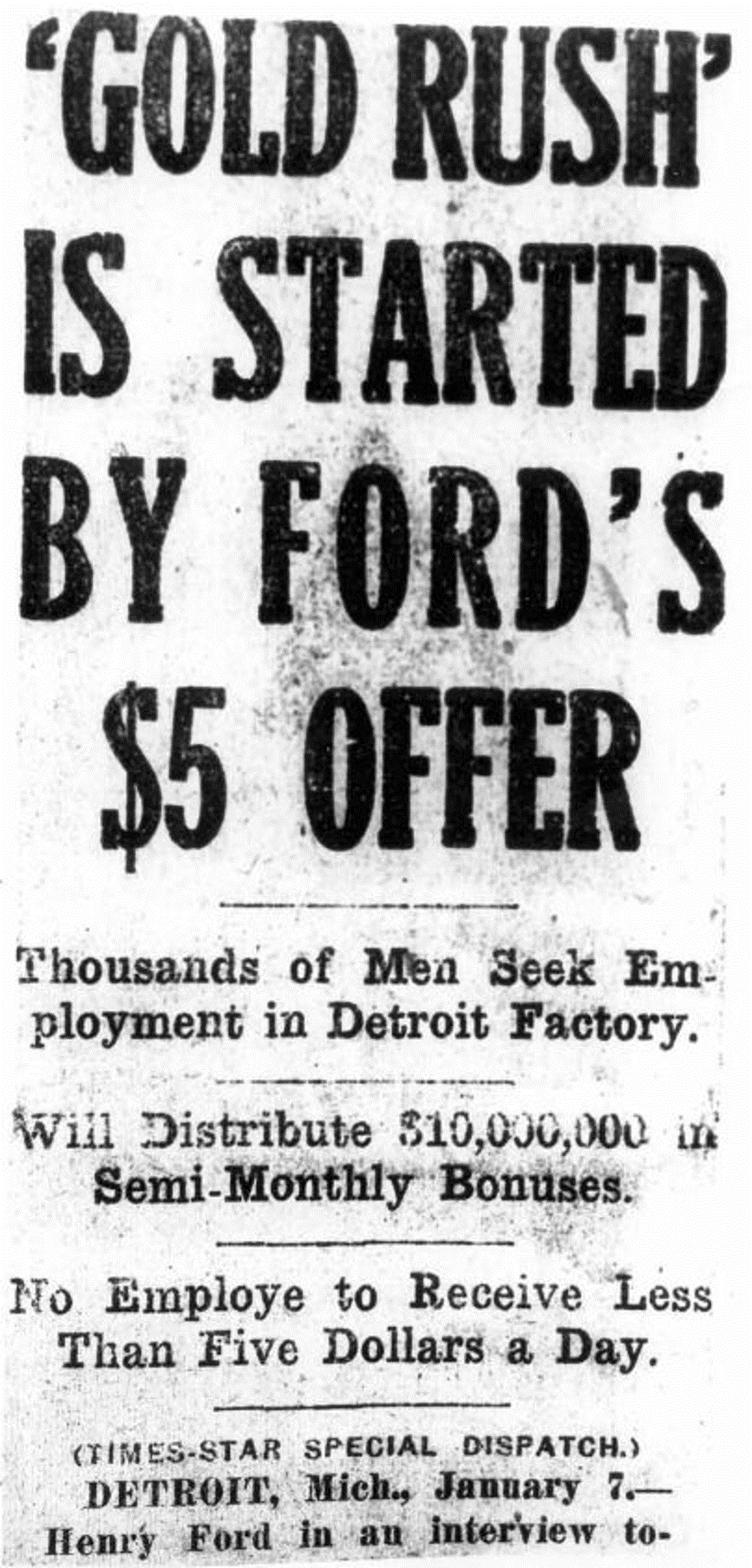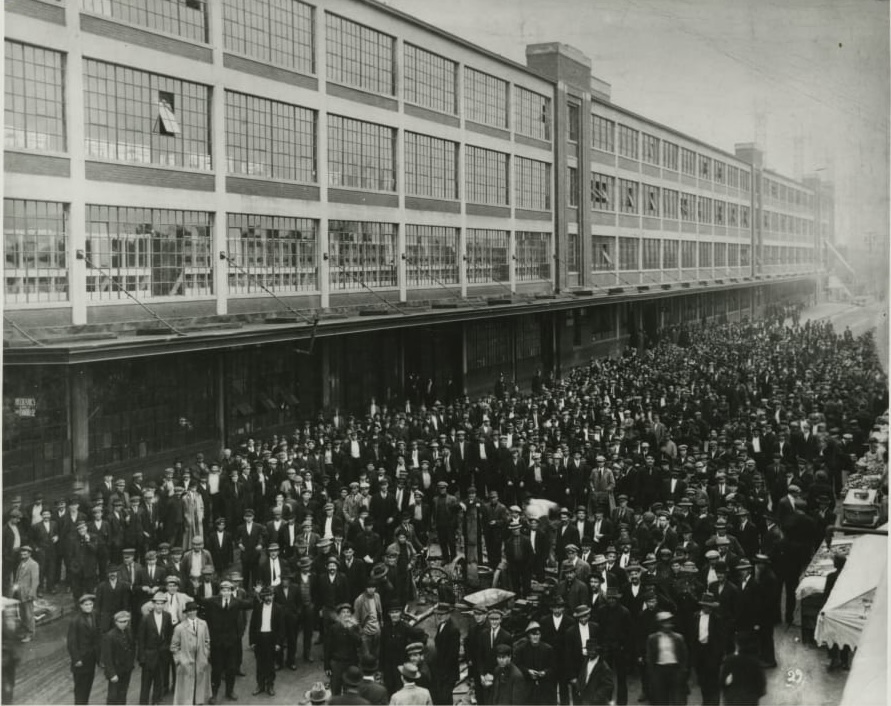Ford’s 5 Dollar Deal
1. Introduction
On January 5, 1914, Ford Motor Company made a bold move by implementing a wage of \$5 per day for an eight‑hour shift—more than double the previous rate of $2.34 for a nine‑hour day. This announcement came amid significant challenges: before the wage increase, the company experienced a staggering 380% labor turnover rate, and workers were increasingly dissatisfied with the monotonous and relentless demands of the moving assembly line1, 2. However, in the wake of the new policy, production output soared—from 202,667 cars in 1913 to 308,162 in 1914 and 501,462 in 1915—and thousands of job seekers flocked to Ford’s employment windows3, 4. This case provides an ideal setting to apply the efficiency wage model, which posits that paying above-market wages can induce higher worker effort, reduce turnover, and improve overall productivity.
For more on the Ford’s 5 dollar wage, see Did Henry Ford Pay Efficiency Wages?5.

2. The Efficiency Wage Model:
Efficiency wage theory challenges the classical view that wages merely clear the labor market. Instead, it suggests that a higher wage increases worker effort and reduces shirking, thereby enhancing productivity. Two key equations capture these ideas:
A. The Profit Function and Effective Labor
The representative firm’s profit function is given by:
\pi = F(eL) - wL,
where:
- F(eL) denotes the production output as a function of “effective labor” (the product of the number of workers L and the effort e they exert),
- w is the wage rate, and
- e is the worker’s effort, which increases with the wage: e = e(w) with e'(w) > 0.
Intuition:
Even if the assembly line work remains as relentless as before, a higher wage w can boost worker effort, e(w), effectively making each worker more productive. For Ford, the promise of \$5 per day was critical to overcoming the workers’ resistance to the new assembly line discipline.
B. Optimal Wage Determination
When a firm chooses both the wage w and the number of workers L, two first‑order conditions arise:
Marginal Product Condition:
F'(e(w)L) = \frac{w}{e(w)}
This condition ensures that the marginal product of effective labor equals its cost.
Efficiency Wage (Elasticity) Condition:
\frac{w \, e'(w)}{e(w)} = 1. \tag{1}
Interpretation:
This condition states that the wage should be set such that the elasticity of worker effort with respect to the wage is unity. In other words, a marginal increase in the wage leads to an exactly proportional increase in effort. Ford’s jump from \$2.34 to \$5 can be seen as an attempt to reach—or exceed—the threshold where any additional wage cost is fully offset by enhanced worker productivity.
3. Historical Statistics and Their Connection to the Model
Let’s now connect the empirical statistics and documented historical observations to the above equations and intuitive framework.
A. Pre-Policy Conditions: Low Wages, High Turnover, and Low Effort
- High Turnover:
- Statistic: In late 1913, Ford Motor Company experienced a turnover rate of 380%6.
- Model Connection: A low wage implies low worker effort e(w), as suggested by the monotonic relationship e'(w) > 0. With insufficient compensation, workers had little incentive to commit to the strenuous work, leading to high turnover. The effective cost per unit of labor, \frac{w}{e(w)}, was high in practice because productivity suffered due to low effort and frequent rehiring costs.
- Statistic: In late 1913, Ford Motor Company experienced a turnover rate of 380%6.
- Assembly Line Challenges:
- Statistic: The moving assembly line reduced chassis assembly time dramatically—from over 12 hours to just 2 hours and 40 minutes—but also made work more monotonous7, 8.
- Model Connection: The rapid pace required workers to exert high effort. However, under low wages, the induced effort e(w) was inadequate, contributing to dissatisfaction and turnover. The assembly line’s efficiency potential was not fully realized until worker incentives were realigned with the higher wage.
- Statistic: The moving assembly line reduced chassis assembly time dramatically—from over 12 hours to just 2 hours and 40 minutes—but also made work more monotonous7, 8.
B. Post-Policy Outcomes: High Wages, Elevated Effort, and Improved Productivity

- Dramatic Increase in Production Output:
- Statistics: Production output jumped from 202,667 cars in 1913 to 308,162 in 1914, and then to 501,462 in 19159.
- Model Connection: According to the production function F(eL), an increase in worker effort e(w) directly boosts output. By setting w high enough to satisfy the elasticity condition (Equation 1), Ford ensured that each worker’s effective labor increased substantially, leading to higher overall production.
- Statistics: Production output jumped from 202,667 cars in 1913 to 308,162 in 1914, and then to 501,462 in 19159.
- Surge in Job Applications and Worker Retention:
- Statistics: The day after the wage announcement, approximately 10,000 job seekers gathered at Ford’s employment window, with some arriving as early as 3 a.m.10. Post-policy, the turnover issue effectively disappeared11.
- Model Connection: The attractiveness of a wage significantly above the prevailing market rate (w > w_a) draws a larger pool of applicants. In an extended efficiency wage model where worker effort also depends on the prevailing wage w_a and the unemployment rate u (i.e., e = e(w, w_a, u)), a high wage acts as a strong signal that increases e(w) while ensuring that only workers committed to the work—and capable of performing under strict conditions—are retained. This screening mechanism further enhances the overall productivity and reduces turnover.
- Statistics: The day after the wage announcement, approximately 10,000 job seekers gathered at Ford’s employment window, with some arriving as early as 3 a.m.10. Post-policy, the turnover issue effectively disappeared11.
- Economic and Social Impact:
- Statistic: Ford’s wage increase is credited with boosting thousands of workers into the middle class, enabling them to afford the very Model Ts they helped produce12, 13.
- Model Connection: Beyond productivity, higher wages improve worker welfare. In efficiency wage models, the wage premium not only induces higher effort but also fosters greater loyalty and a higher quality of labor force, creating a virtuous cycle that benefits both the firm and its workers.
- Statistic: Ford’s wage increase is credited with boosting thousands of workers into the middle class, enabling them to afford the very Model Ts they helped produce12, 13.
4. Intuitive Synthesis: Why Ford’s Policy “Worked”
Combining the statistics with the model’s predictions, we can summarize the intuitive rationale behind Ford’s policy as follows:
- Before the Wage Increase:
- Low w led to low e(w): Workers were not sufficiently motivated by the low wages to exert the high levels of effort required by the new assembly line methods. This misalignment resulted in a turnover rate of 380%14, which in turn increased the effective cost of labor due to recruitment and training costs.
- After the Wage Increase:
- High w induced high e(w): By raising the wage to \$5 per day, Ford achieved the condition where the elasticity of effort with respect to the wage (\frac{w \, e'(w)}{e(w)} = 1) was met. The higher wage provided sufficient incentive to increase worker effort proportionately, thereby reducing turnover and increasing production output dramatically15, 16.
- Worker Attraction and Screening: The premium wage attracted a flood of applicants and allowed Ford to screen for those willing to accept the demanding conditions—ensuring a more productive and committed workforce.
- Overall Economic Impact:
- Improved Productivity and Social Mobility: The increased output, combined with improved worker retention, lowered the effective cost per unit of effective labor \left(\frac{w}{e(w)}\right). This not only made the production process more efficient but also uplifted workers into the middle class, as they could now afford the products they helped manufacture17, 18.
5. Conclusion
Henry Ford’s \$5 wage policy is a striking illustration of the efficiency wage theory in practice. The policy’s dramatic impact on production output, worker retention, and job applications can be directly linked to the key model equations:
- The profit function \pi = F(eL) - wL shows how effective labor eL is crucial for output.
- The condition \frac{w \, e'(w)}{e(w)} = 1 guarantees that any increase in wages is exactly matched by an increase in worker effort, thereby lowering the cost per effective unit of labor.
By setting a wage substantially above the prevailing rate, Ford transformed a demoralized workforce into a highly productive team, reduced excessive turnover, and ultimately reshaped industrial relations. These outcomes are supported by historical statistics19, 20, 21, 22 and align perfectly with the theoretical predictions of the efficiency wage model.
References
The Henry Ford. “Expert Sets on the Ford Motor Company Archives.” Link↩︎
Kellogg School of Management, Northwestern University. “Henry Ford’s Five Dollar Day.” Link↩︎
The Henry Ford. “Frequently Asked Questions on Ford Production.” Link↩︎
The Henry Ford. “Expert Sets on the Ford Motor Company Archives.” Link↩︎
The Henry Ford. “Expert Sets on the Ford Motor Company Archives.” Link↩︎
The Henry Ford. “Frequently Asked Questions on Ford Production.” Link↩︎
Kellogg School of Management, Northwestern University. “Henry Ford’s Five Dollar Day.” Link↩︎
The Henry Ford. “Expert Sets on the Ford Motor Company Archives.” Link↩︎
Kellogg School of Management, Northwestern University. “Henry Ford’s Five Dollar Day.” Link↩︎
The Henry Ford. “Expert Sets on the Ford Motor Company Archives.” Link↩︎
The Henry Ford. “Expert Sets on the Ford Motor Company Archives.” Link↩︎
The Henry Ford. “Frequently Asked Questions on Ford Production.” Link↩︎
Kellogg School of Management, Northwestern University. “Henry Ford’s Five Dollar Day.” Link↩︎
Kellogg School of Management, Northwestern University. “Henry Ford’s Five Dollar Day.” Link↩︎
The Henry Ford. “Expert Sets on the Ford Motor Company Archives.” Link↩︎
Kellogg School of Management, Northwestern University. “Henry Ford’s Five Dollar Day.” Link↩︎
The Henry Ford. “Expert Sets on the Ford Motor Company Archives.” Link↩︎
The Henry Ford. “Frequently Asked Questions on Ford Production.” Link↩︎
